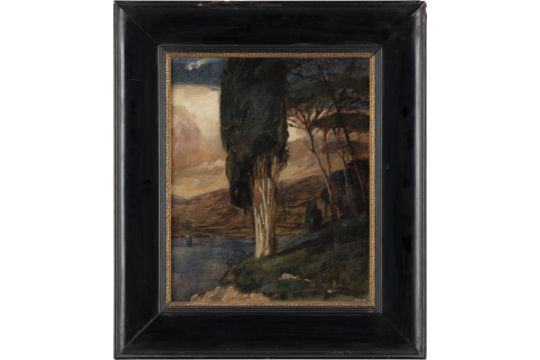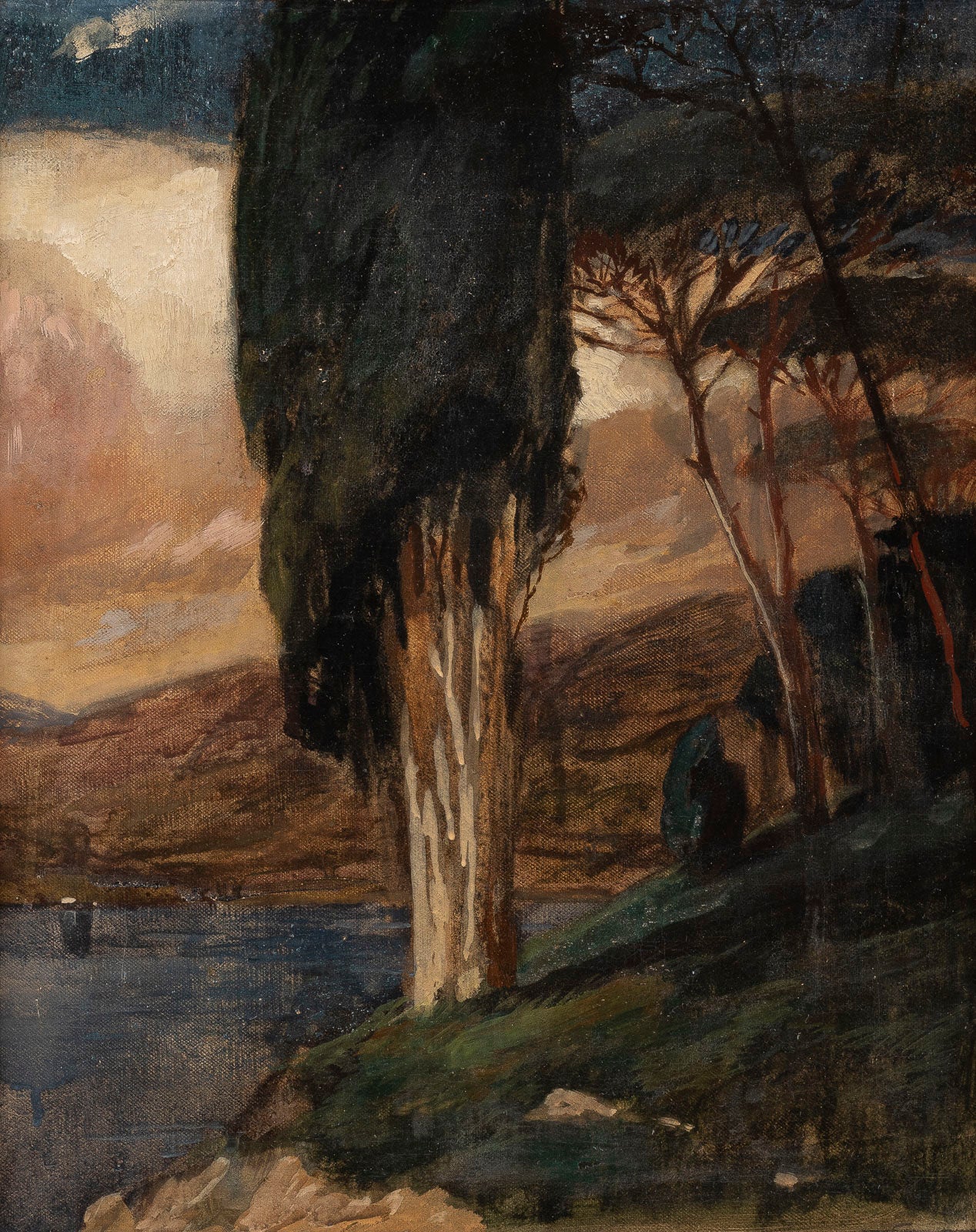Artemisia Fine Arts & Antiques Ltd
Arnold Böcklin Circle Cypress Shore c.1860 - Symbolist Landscape Oil Painting
Arnold Böcklin Circle Cypress Shore c.1860 - Symbolist Landscape Oil Painting
Couldn't load pickup availability
Cypress (Cupressus sempervirens) by the Shore - Arnold Böcklin (Circle of), c.1860
A magnificent and atmospheric oil painting depicting a solitary cypress tree by the shore, attributed to the Circle of Arnold Böcklin (1827-1901), one of the most important Symbolist painters of the 19th century. Dating to circa 1860, this evocative landscape captures the mysterious, melancholic beauty characteristic of Böcklin's work and the Symbolist movement. The painting's moody atmosphere, dramatic composition, and the iconic cypress motif - central to Böcklin's artistic vocabulary - make this a significant example of mid-19th century Symbolist landscape painting.
Arnold Böcklin - Master of Symbolist Painting
Arnold Böcklin (1827-1901) stands as one of the most influential Symbolist painters of the 19th century, renowned for his mysterious, dreamlike landscapes that blend naturalistic observation with mythological and allegorical elements. Born in Basel, Switzerland, Böcklin spent much of his career in Italy, where the Mediterranean landscape, classical ruins, and Italian light profoundly influenced his work. His paintings, particularly his famous 'Island of the Dead' series, captured the imagination of late 19th-century audiences and influenced generations of artists, writers, and composers. Böcklin's work bridges Romanticism and Symbolism, combining meticulous observation of nature with profound psychological and philosophical depth.
Circle of Böcklin - Attribution and Significance
The attribution "Circle of Arnold Böcklin" indicates this painting was created by an artist working closely with Böcklin, possibly a student, follower, or contemporary strongly influenced by his style and subject matter. Such attributions are common in 19th-century painting and indicate the work demonstrates characteristic techniques, compositional approaches, and thematic concerns of the named master while not being definitively by his hand. Circle paintings often represent excellent quality and can be more accessible than works by the master himself, while still embodying the artistic tradition and aesthetic vision of the school.
The Cypress Motif - Symbolist Icon
The cypress tree (Cupressus sempervirens) holds profound symbolic significance in Böcklin's work and Symbolist art generally. In Mediterranean and classical traditions, cypresses symbolize death, mourning, and the passage between earthly and spiritual realms. Their distinctive vertical forms, dark foliage, and association with cemeteries made them perfect vehicles for Symbolist exploration of mortality, melancholy, and transcendence. Böcklin frequently featured cypresses in his landscapes, most famously in his 'Island of the Dead' paintings. This painting's focus on a solitary cypress by the shore continues Böcklin's meditation on these themes.
Composition and Atmosphere
The painting depicts a solitary cypress tree positioned by the shore, likely the Mediterranean coast that so captivated Böcklin and his circle. The composition's simplicity - a single tree against water and sky - creates powerful focus and emotional intensity. The atmospheric treatment, with its moody lighting and evocative color palette, generates the sense of mystery and melancholy characteristic of Symbolist landscape. The shore setting, with its liminal quality between land and water, earth and infinity, enhances the painting's metaphysical resonance.
Circa 1860 Dating - Böcklin's Mature Period
The circa 1860 dating places this painting during Böcklin's mature period when he was developing the distinctive style that would make him famous. By 1860, Böcklin had spent significant time in Italy, absorbed Mediterranean light and landscape, and was synthesizing Romantic landscape traditions with emerging Symbolist sensibilities. Works from this period show Böcklin and his circle exploring the themes and motifs that would define Symbolist landscape painting - mysterious atmospheres, symbolic natural elements, and psychological depth.
Technical Excellence - Oil on Canvas
Executed in oil on canvas, this painting demonstrates accomplished technique in atmospheric landscape painting. The artist's handling of light, color, and atmospheric effects creates convincing sense of place and mood. The cypress is rendered with attention to its characteristic form and texture, while the shore, water, and sky are treated with the tonal subtlety and atmospheric depth characteristic of finest 19th-century landscape painting. The overall execution shows an artist thoroughly trained in academic landscape techniques while employing them for Symbolist purposes.
Symbolist Movement Context
This painting exemplifies the Symbolist movement's approach to landscape - using natural elements not merely for descriptive purposes but as vehicles for psychological, philosophical, and spiritual expression. Symbolist artists rejected both academic idealization and Impressionist emphasis on optical sensation, instead seeking to express inner states, universal truths, and metaphysical realities through carefully chosen symbols and evocative atmospheres. This cypress painting, with its solitary tree, liminal shore setting, and moody atmosphere, embodies these Symbolist concerns.
Italian Influence - Mediterranean Light
The painting likely depicts an Italian or Mediterranean coastal scene, reflecting Böcklin's deep engagement with Italian landscape and light. The cypress, native to the Mediterranean, and the coastal setting suggest the Italian environment that profoundly influenced Böcklin and his circle. This Italian connection adds cultural and art historical significance, linking the painting to the long tradition of Northern European artists finding inspiration in Italy's landscape, light, and classical heritage.
Condition and Preservation
As a painting approximately 165 years old, condition assessment is crucial. The painting's current state, any restoration history, and structural integrity should be evaluated by conservation professionals. Many 19th-century oil paintings have survived remarkably well due to the durability of oil paint and canvas, though most show some age-related changes. Detailed condition reports available to serious collectors, documenting any restoration, overpainting, or structural issues.
Provenance and Authentication
Attribution to the Circle of Arnold Böcklin suggests scholarly examination and comparison with documented works by the master and his associates. Comprehensive provenance research, technical analysis, and expert authentication available to serious collectors. Understanding the painting's history, previous ownership, and scholarly documentation enhances both historical interest and market value.
Investment Value and Market Position
Paintings by the Circle of Arnold Böcklin represent solid investment opportunities in the 19th-century Symbolist market. Böcklin's enduring reputation, the Symbolist movement's continued scholarly and collector interest, and the painting's evocative subject matter create strong appeal among collectors of Symbolist art, 19th-century landscape, and German/Swiss painting. As authentic period Symbolist works become scarcer, quality examples show consistent market performance.
Cultural and Art Historical Significance
This painting embodies the Symbolist movement's profound influence on late 19th and early 20th-century culture. Symbolist art influenced not just painting but literature, music, theater, and early cinema. Böcklin's work specifically inspired composers (Rachmaninoff's 'Isle of the Dead'), writers (D'Annunzio), and Surrealist artists (Dalí, de Chirico). Owning a work from Böcklin's circle means connecting with this rich cultural legacy and the movement that helped shape modern art.
Collecting Context
This painting appeals to collectors of Symbolist art, 19th-century landscape, German and Swiss painting, and those seeking works with psychological depth and philosophical resonance. It would enhance private collections, corporate holdings, or institutional acquisitions focused on Symbolist movement or 19th-century European painting.
Display and Presentation
A painting of this atmospheric quality deserves placement where its moody beauty and contemplative character can be appreciated. Ideal locations include libraries, studies, formal living areas, or galleries where the painting's meditative qualities enhance the environment. Proper lighting reveals the subtle tonal qualities and atmospheric effects. Climate-controlled environment essential for long-term preservation.
Available for viewing by appointment at Artemisia Fine Arts & Antiques Ltd, Malta's premier gallery for 19th-century European painting. We provide expert consultation, authentication services, conservation coordination, provenance research, insurance valuation, and international shipping with specialized fine art handlers. This represents an exceptional acquisition opportunity for collectors of Symbolist painting and 19th-century landscape art. Serious inquiries from qualified collectors welcome.
Share






